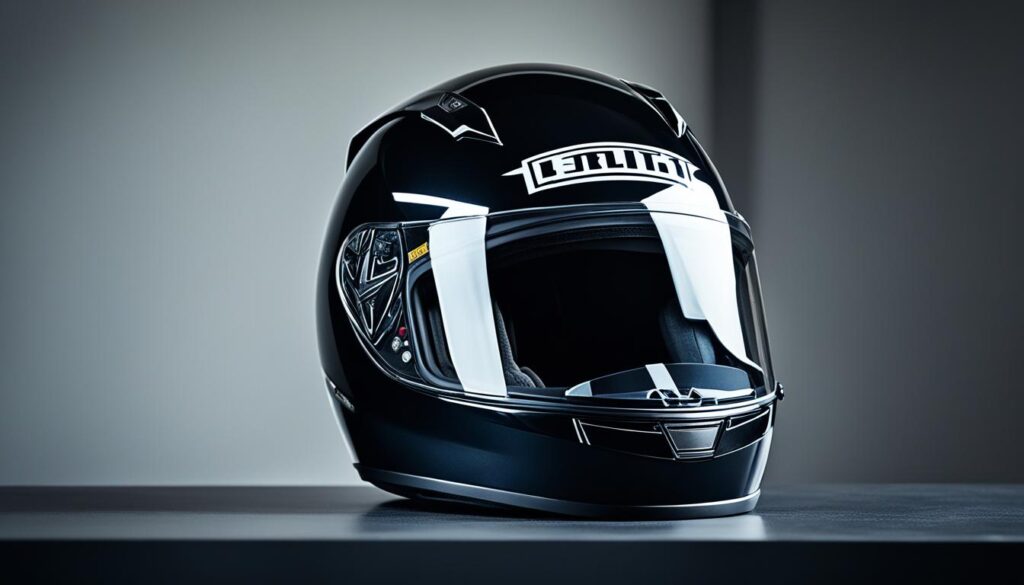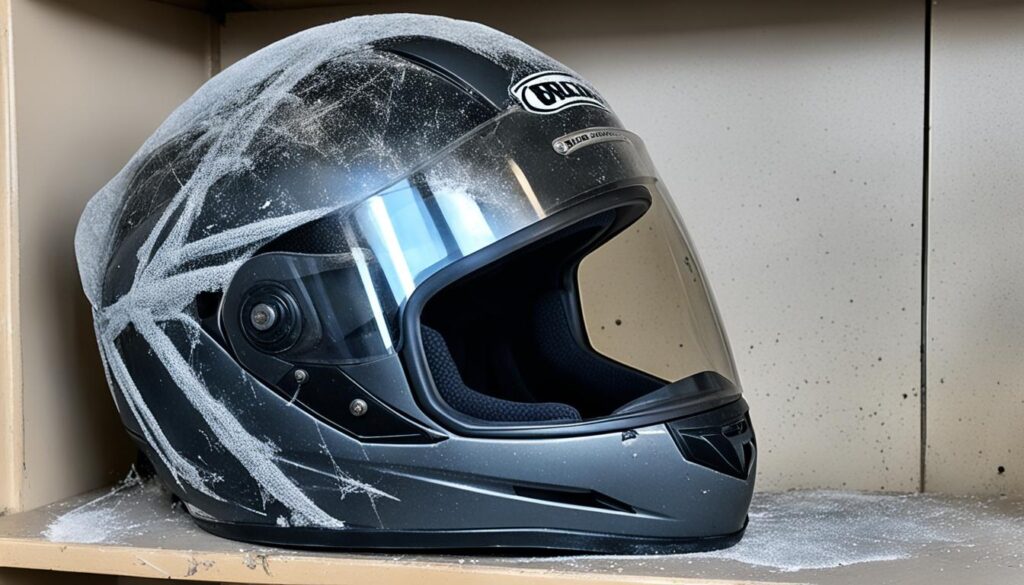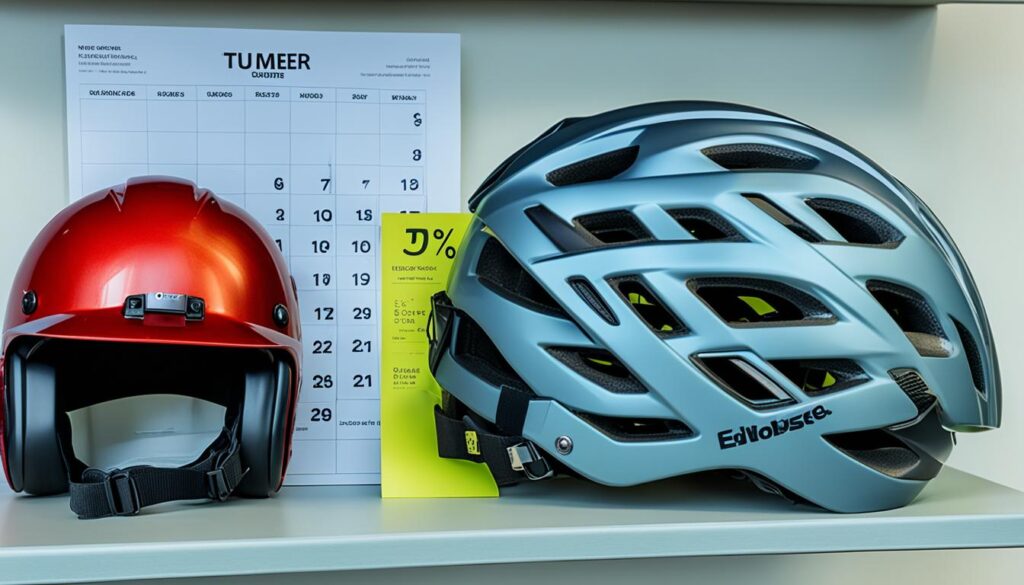
When it comes to motorcycle safety gear, there’s one item that can literally be the difference between life and death: the helmet. But how long is a motorcycle helmet actually good for? Is it a one-time investment, or do you need to consider replacing it after a certain period of time?
Many riders may assume that as long as their helmet looks fine and hasn’t been involved in a crash, it’s still good to go. However, there are important factors that determine the lifespan of a motorcycle helmet that go beyond appearance alone.
In this article, I will explore the recommended lifespan of a motorcycle helmet, the signs to look for when inspecting your helmet for damage, and the various factors that can affect its durability. So, let’s dive in and unravel the mysteries surrounding helmet lifespan!
Key Takeaways:
- The general recommendation is to replace your motorcycle helmet every five years, regardless of its appearance or lack of accidents.
- Factors such as frequency of use, storage conditions, and helmet quality can impact the helmet’s lifespan.
- Inspect your helmet regularly for damage, including cracks, frayed straps, and deteriorated padding.
- Advancements in helmet technology offer better protection, ventilation, and comfort, making it advantageous to upgrade to a new helmet.
- Proper care and storage, such as keeping it in a dry location and cleaning it regularly, can help extend the helmet’s lifespan.
Inspecting Your Helmet for Damage
Regular inspection of your motorcycle helmet is crucial to ensure its safety and durability. By paying attention to certain areas, you can identify potential issues and take appropriate action to maintain your helmet’s effectiveness. Here are the key parts to inspect:
1. Chin Strap
The chin strap is an essential component of the helmet, keeping it securely in place during rides. Regularly check the strap for any signs of fraying or damage. If you notice any issues, it’s important to replace the strap promptly to ensure a proper fit and secure hold.
2. Inner Padding
Excess sweat and moisture can cause the padding inside your helmet to deteriorate over time. Inspect the inner padding for signs of disintegration or missing pads. If you notice any degradation, consider replacing the foam inserts to maintain optimal comfort and protection.
3. Outer Shell
The outer shell of your helmet is responsible for absorbing and dispersing the impact energy in case of a crash. It’s crucial to carefully examine the shell for any signs of damage, including color fading, cracks, or fractures. These issues can compromise the structural integrity of the helmet and reduce its ability to protect you. If your helmet has been involved in an accident, it should be replaced immediately, regardless of the visible damage.
Regularly inspecting these key areas of your helmet will help ensure that it remains in good condition and provides the necessary protection on your rides.
| Area | What to Check | Action Needed |
|---|---|---|
| Chin Strap | Fraying or damage | Replace if necessary |
| Inner Padding | Disintegration or missing pads | Consider replacing foam inserts |
| Outer Shell | Color fading, cracks, or fractures | Replace immediately if involved in an accident |
Regular inspection of your helmet for damage is an essential part of helmet maintenance. By following these guidelines, you can ensure that your helmet remains safe and durable, providing you with the necessary protection on the road.
Factors Affecting Helmet Lifespan
Several factors can affect the lifespan of a motorcycle helmet:
- Impact of Usage Frequency: The more often a helmet is used, the faster it may degrade. Daily riders may need to replace their helmets more frequently than occasional riders.
- Personal Chemistry Effects: Some individuals’ sweat can react with the helmet materials and accelerate deterioration. This is rare but worth considering.
- Environmental Influences: Heat, humidity, and exposure to certain chemicals can impact a helmet’s lifespan. Helmets exposed to high levels of humidity or chemicals may have a shorter lifespan.
- Sunlight and UV Concerns: While sunlight can cause paint or graphics to fade, it is unlikely to significantly damage the structural integrity of a helmet’s shell. Modern helmets with composite shells are designed to resist UV damage.
- Advancements in Helmet Technology: Over time, helmet technology improves, offering better protection, ventilation, and comfort. Helmets that are several years old may not offer the same level of effectiveness as newer models.
These factors should be taken into consideration when determining the lifespan of a motorcycle helmet. Regular inspections, maintenance, and staying informed about the latest helmet technology can help riders make informed decisions about when to replace their helmets for optimal safety and protection on the road.
When to Replace an Unused Helmet
Even if a helmet has not been used, it can still degrade over time. Evaporation, chemical exposure, and natural material degradation can affect an unused helmet’s lifespan. There is no exact timeframe, but it is generally recommended to replace a helmet that has been sitting unused for more than 5-10 years. The risk of using an older helmet outweighs any potential cost savings, especially considering the advancements in helmet technology.

| Factors | Unused Helmet Lifespan |
|---|---|
| Age | 5-10 years or more |
| Stored properly | May extend lifespan |
Ensuring Proper Helmet Care and Storage
Maintaining proper care and storage practices is essential for optimizing the durability and longevity of your motorcycle helmet. By implementing these tips, you can keep your helmet in optimal condition and ensure its effectiveness when you need it most.
Store in a Dry Location
It is crucial to store your helmet in a dry and well-ventilated area. Moisture can damage the helmet’s materials and potentially compromise its structural integrity. Avoid leaving your helmet in damp basements or exposed to extreme humidity, as these conditions can accelerate deterioration.
Clean Regularly
To keep your helmet looking and smelling fresh, it is important to clean it regularly. Use a mild soap or specialized helmet cleaner to wipe down the helmet’s exterior. This will help remove dirt, grime, and sweat that can accumulate over time. Do not use harsh chemicals or solvents as they can damage the helmet’s materials.
Follow Manufacturer Guidelines
Manufacturers provide specific maintenance recommendations and cleaning methods for their helmets. It is important to refer to the manufacturer’s instructions to ensure you are following the proper care guidelines. By adhering to these guidelines, you can avoid damaging the helmet and maximize its lifespan.
Avoid Harsh Chemicals
Harsh chemicals and solvents can degrade the materials of your helmet. Avoid using products that contain bleach, ammonia, or other strong chemicals when cleaning your helmet. Stick to mild soaps or helmet-specific cleaners to maintain the integrity of the helmet’s components.
Handle with Care
Handle your helmet with care to prevent any accidental damage. Avoid dropping or mishandling the helmet, as this can lead to structural damage and compromise its safety features. Treat your helmet as a valuable piece of equipment and handle it with the necessary caution to ensure its longevity.
By implementing these proper care and storage practices, you can extend the durability of your helmet and ensure its effectiveness throughout its lifespan. Remember, a well-maintained helmet is a critical element in your overall motorcycle gear longevity and your safety on the road.

Understanding Helmet Damage and Safety Risks
When it comes to motorcycle safety, understanding the risks of using a damaged helmet is crucial. Your helmet is your first line of defense in an accident, and its structural integrity plays a vital role in providing adequate protection. Small cracks, dents, or missing components can significantly compromise the effectiveness of your helmet, making it essential to replace a damaged helmet rather than attempting to repair it.
Using a damaged helmet increases the risk of head injuries in the event of a crash. Even the smallest cracks or dents can weaken the overall structure, reducing the helmet’s ability to absorb impact and distribute force. Additionally, missing components can affect the helmet’s stability and fit, further decreasing its protective capabilities.
Therefore, if you notice any signs of damage such as cracks, dents, or missing parts, it’s crucial to replace your helmet promptly. Prioritizing your safety on the road is paramount, and investing in a new, undamaged helmet is a smart decision.
“A helmet with compromised structural integrity may not provide adequate protection in the event of an accident.”
Factors Impacting Helmet Safety
Several factors can impact the safety of your helmet and its ability to protect you effectively on your motorcycle adventures. These factors include:
- Accident History: If your helmet has been involved in a crash, it should always be replaced, regardless of visible damage. Even if there are no visible signs of damage, the impact may have compromised the helmet’s structural integrity.
- Proper Fit: A helmet that doesn’t fit correctly may not provide the desired level of protection. Ensure that your helmet is snug and secure without being overly tight or loose.
- Helmet Age: Over time, helmet materials may degrade, making the helmet less effective in protecting against impact. While there are general recommendations for helmet replacement, it’s important to assess the condition of your helmet regularly.
By considering these factors and prioritizing regular helmet inspections and replacements, you can maintain optimal safety while riding.
| Hazard | Impact on Helmet Safety |
|---|---|
| Cracks or dents | Weakens the overall structure and reduces impact absorption capabilities |
| Missing components | Affects helmet stability and fit, compromising overall protection |
Repairing vs. Replacing a Damaged Helmet
While it may be tempting to repair a damaged helmet, it is generally recommended to replace it instead. Helmet manufacturers do not recommend repairing helmets due to the potential compromises in structural integrity that can occur during the repair process. It’s crucial to prioritize safety and choose a new helmet that meets current safety standards.
Remember, your helmet is an investment in your safety on the road. By understanding the potential risks of using a damaged helmet and promptly replacing it, you can ensure optimal protection and peace of mind during your motorcycle journeys.
Advantages of Upgrading to a New Helmet
When it comes to motorcycle helmet safety, upgrading to a new helmet offers a range of benefits that can enhance your riding experience. Let’s explore some of the advantages:
- Enhanced Safety: Newer helmets are designed with advanced safety features and improved technology that provide better protection in the event of a crash. These helmets undergo rigorous testing to meet safety standards, ensuring optimal head protection.
- Improved Comfort: Upgrading to a new helmet allows you to enjoy improved comfort during your rides. Newer helmets often feature better ventilation systems, moisture-wicking liners, and improved fit systems. These advancements contribute to a more comfortable and enjoyable riding experience.
- Updated Style: Helmet designs and aesthetics evolve over time, reflecting current trends. By upgrading to a new helmet, you have the opportunity to choose a style that suits your preferences and adds a touch of personal flair to your riding gear.
- Peace of Mind: Knowing that you are using a reliable, up-to-date helmet can give you peace of mind and boost your confidence on the road. With the latest helmet technology at your disposal, you can ride with the assurance that you have taken all necessary safety measures.
Investing in a new helmet not only prioritizes motorcycle helmet safety but also ensures that you have the most up-to-date features, comfort, and style. Taking advantage of the advancements in helmet technology is a smart choice for any rider looking to enhance their riding experience while prioritizing safety.
Conclusion
After considering various factors such as usage frequency, storage conditions, and helmet quality, it is clear that the lifespan of a motorcycle helmet can vary. While manufacturers generally recommend replacing helmets every five years, it is important to regularly inspect your helmet for signs of damage and deterioration to ensure your safety on the road.
Upgrading to a new helmet offers numerous benefits, including improved safety features, enhanced comfort, and peace of mind while riding. The advancements in helmet technology provide better protection in the event of a crash, while modern designs cater to both style and functionality.
Remember, investing in a new helmet is an investment in your safety. A helmet is an essential piece of protective gear that should not be compromised. By adhering to replacement guidelines and prioritizing regular inspections, you can ensure optimal protection on your rides.
Source Links
- https://www.cardosystems.com/blog/do-motorcycle-helmets-expire-when-to-replace-your-motorcycle-helmet/
- https://agvsport.com/blog/helmets/do-motorcycle-helmets-expire-if-not-used.html
- https://www.motolegends.com/reviews/When-should-I-replace-my-motorcycle-helmet
Recommended

Meet James Smith, affectionately known by friends as ‘Biker Smith’, your go-to expert at ‘Best HD Helmet Camera’. At 35, living in the USA, James embodies the spirit of adventure. His life is a thrilling ride, powered by his Harley Davidson Softail and BMW S 1000 RR, with his girlfriend as his favorite travel companion. A software developer by profession, James’s heart beats for the open road, making him a full-time traveler at heart. His passion for biking and technology merges seamlessly on this platform. Recognizing a gap in discussions around helmet cameras, he founded this blog to educate and inspire fellow enthusiasts. His mission? To elevate your riding experience with the best HD helmet camera insights, backed by firsthand experiences, rigorous testing, and a genuine love for the ride. Trust James to guide you through the world of helmet cameras, where quality, innovation, and safety ride together.